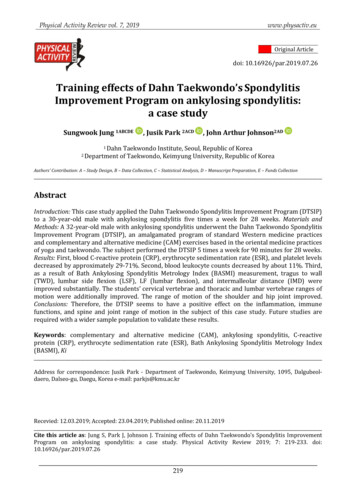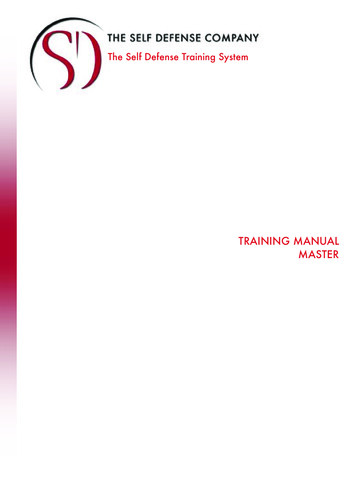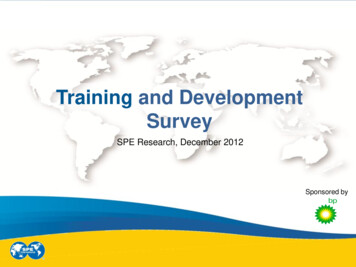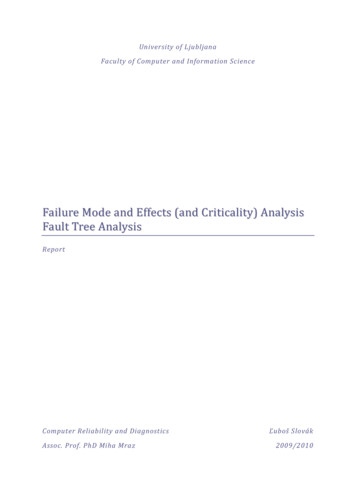
Transcription
Physical Activity Review vol. 7, 2019www.physactiv.euOriginal Articledoi: 10.16926/par.2019.07.26Training effects of Dahn Taekwondo’s SpondylitisImprovement Program on ankylosing spondylitis:a case studySungwook Jung 1ABCDE, Jusik Park 2ACD, John Arthur Johnson2AD1 Dahn2 DepartmentTaekwondo Institute, Seoul, Republic of Koreaof Taekwondo, Keimyung University, Republic of KoreaAuthors' Contribution: A – Study Design, B – Data Collection, C – Statistical Analysis, D – Manuscript Preparation, E – Funds CollectionAbstractIntroduction: This case study applied the Dahn Taekwondo Spondylitis Improvement Program (DTSIP)to a 30-year-old male with ankylosing spondylitis five times a week for 28 weeks. Materials andMethods: A 32-year-old male with ankylosing spondylitis underwent the Dahn Taekwondo SpondylitisImprovement Program (DTSIP), an amalgamated program of standard Western medicine practicesand complementary and alternative medicine (CAM) exercises based in the oriental medicine practicesof yoga and taekwondo. The subject performed the DTSIP 5 times a week for 90 minutes for 28 weeks.Results: First, blood C-reactive protein (CRP), erythrocyte sedimentation rate (ESR), and platelet levelsdecreased by approximately 29-71%. Second, blood leukocyte counts decreased by about 11%. Third,as a result of Bath Ankylosing Spondylitis Metrology Index (BASMI) measurement, tragus to wall(TWD), lumbar side flexion (LSF), LF (lumbar flexion), and intermalleolar distance (IMD) wereimproved substantially. The students’ cervical vertebrae and thoracic and lumbar vertebrae ranges ofmotion were additionally improved. The range of motion of the shoulder and hip joint improved.Conclusions: Therefore, the DTSIP seems to have a positive effect on the inflammation, immunefunctions, and spine and joint range of motion in the subject of this case study. Future studies arerequired with a wider sample population to validate these results.Keywords: complementary and alternative medicine (CAM), ankylosing spondylitis, C-reactiveprotein (CRP), erythrocyte sedimentation rate (ESR), Bath Ankylosing Spondylitis Metrology Index(BASMI), KiAddress for correspondence: Jusik Park - Department of Taekwondo, Keimyung University, 1095, Dalgubeoldaero, Dalseo-gu, Daegu, Korea e-mail: parkjs@kmu.ac.krRecevied: 12.03.2019; Accepted: 23.04.2019; Published online: 20.11.2019Cite this article as: Jung S, Park J, Johnson J. Training effects of Dahn Taekwondo’s Spondylitis ImprovementProgram on ankylosing spondylitis: a case study. Physical Activity Review 2019; 7: 219-233. doi:10.16926/par.2019.07.26219
Physical Activity Review vol. 7, 2019www.physactiv.euINTRODUCTIONThe development of today’s dependency on scientific advancements has increased thephysical and mental dissonance due to a decrease in physical activity and overeating [1]. Patients withlifestyle-related diseases are on the rise every year. Lee [2] reported that the diseases caused byabnormalities of immune function (e.g., autoimmune diseases) and allergies (e.g., ulcerative colitis andCrohn’s disease) are increasing continuously. An autoimmune disease is a disease caused whena body’s immune system attacks its organs. Systemic lupus erythematosus, allergic rhinitis,rheumatoid arthritis, and ankylosing spondylitis are such diseases. The cause of autoimmune diseasein both Western medicine and Oriental medicine practices has not been clearly elucidated,so a universal therapy method has yet to be developed. In particular, ankylosing spondylitis requiresconstant symptom management, because the disease may worsen without proper care of its symptoms.Ankylosing spondylitis is an inflammatory disease predominant in young males in their 20sand 30s that is caused by autoimmunity. There are about 1 to 2 cases per 1,000 people of ankylosingspondylitis, and its world prevalence rate ranges from 0.1 to 1.4% [3]. It is characterized by theimmune system attacking the ligaments that connect the vertebrae, resulting in inflammation andtissue fusing the spine. Symptoms may appear anywhere the autoantibody is attacked, including thespine, knee, heel, and ribs as well as in the eyes, heart, kidney, lung, prostate, and colon. Furthermore,ankylosing spondylitis may cause the ribs to fuse to the spine or sternum, which may hamper deepbreathing. This abnormal fusion of bones may impair daily functions. Symptoms include pain andstiffness in the lower back and pelvic region. As such, ankylosing spondylitis is a serious disease thatcauses various pathological symptoms [4].Western and Oriental medicines view the causes of spondyloarthritis diseases like ankylosingspondylitis from different perspectives. Western medicine presumes autoimmune diseases are causedby combined genetic factors, irregular lifestyle, and various environmental factors, such as mentalstress. In Oriental medicine, it is believed that the eosinophils is caused by a circulatory disorderstrikes the various tissues in our body and causes inflammation. Because of these different viewpointson the cause of spondyloarthritis, Western medicine and Oriental medicine have different therapeuticapproaches.Western medicine mainly treats ankylosing spondylitis with surgery, medication, and exercisetherapy. Amongst them, medication is mainly used to control the inflammation while reducing painand stiffness. However, it is reported that continuous drug therapy is accompanied by variouscomplications including gastrointestinal disorders [5-7]. In Oriental medication, nutritional, andphysical therapies are performed [4]. Previous studies have reported that regular joint mobilityenhancement and strength exercise are more effective than drug and physical therapies in ankylosingspondylitis therapy [8-10]. Analay et al. [11] reported an increase in physical function when anintensive exercise program was applied for 6 weeks to an ankylosing spondylitis patient. Russell,Unsworth, and Haslock [12] reported that 2 to 6 months of physical therapy, including exercisetherapy, was effective in improving ankylosing spondylitis patients’ cervical flexion, extension, androtation. Kraag et al. [13] reported that spasticity increased after 24 months of home exercise in 24patients with ankylosing spondylitis. Zão and Cantista [14] analyzed 35 studies involving a total of2,515 patients with ankylosing spondylitis and reported that the effects of both ground andunderwater exercises were positive. Pécourneau et al. [15] conducted a meta-analysis of 26randomized controlled trials of patients with ankylosing spondylitis and reported that exerciseprograms had a potential to improve disease activity and physical function.In studies conducted within the Republic of Korea (ROK), it was reported that applying homeexercise programs as recommended by the American Society of Spondylitis [16], tai chi [17], andspecial exercise therapies [18] improved joint mobility, daily function, and pain levels in subjects withankylosing spondylitis. As noted above, the existing ankylosing spondylitis exercise studies havefocused on vertebral flexibility, pain, and depression. Korean exercise therapy evaluation toolsincorporated the Bath Ankylosing Spondylitis Functional Index (BASFI), Bath Ankylosing SpondylitisDisease Activity Index (BASANI), and Visual Analogue Scale (VAS) questionnaires. Outside of Korea,spinal movement range measurements, such as the Bath Ankylosing Spondylitis Metrology Index(BASMI), were used as exercise therapy evaluation tools.220
Physical Activity Review vol. 7, 2019www.physactiv.euAn often-discussed concept within Asian studies, medicine, and martial arts is Ki, or internalenergy (i.e., chi, c’hi, or qi). Ki is described typically as an individual’s vital energy that flows throughtheir body along meridians, but is centered in the DanJeon, a point approximately three inches belowthe navel and three inches inside the lower abdomen. The movement and manipulations of Ki are thefoci of Oriental medicine practices. In addition to herbal medicines, Oriental medicine usesacupuncture, acupressure, cupping, massage, and exercise to stimulate Ki in order to treat, andsometimes cure, various ailments and diseases. Some practices have been adopted by professionalWestern martial artists; proof of which can be seen occasionally on mixed marital art (MMA) fighters’bodies in the form of circular bruises left by suction cups after cupping therapy. Little studied byWestern science (probably due to it being interpreted, at best, as a phenomenological experience and,at worst, mysticism), Ki is accepted as fact and a normal phenomenon in the ROK. Indeed, the ROK’sNational Health Insurance (NHIS) recognizes and insures Oriental medical practices just as equally astheir Western counterparts.Taekwondo, a Korean martial art turned Olympic sport, may be practiced for a plethora ofhealth purposes, including interventions to improve overall physical health [19-22], body intelligenceand brain connectivity [23], and obesity [24]. Moreover, “practicing martial arts [like taekwondo] aidsstudents in the development aerobic endurance, muscular strength and endurance, joint flexibility,balance, and coordination” [25]. Taekwondo has also been adapted for various religious pursuits:various “Taekwondo for Christ,” Taoism, and Buddhist mediation programs have sprung up across theworld, all purporting taekwondo practice advances those practices.Interest in complementary and alternative medicine (CAM) therapies began growing aroundthe turn of the millennium [26]. Yoga is another Eastern practice that emphasizes stretching andbreath control. It is a cost-effective, CAM therapy [27] that has shown to be an effective therapy forspondyloarthritis [28] and chronic lower back pain [29]. Dahn Taekwondo is a holistic practiceadvocated by Dahn Yoga & Health Centers (now called Body & Brain) that combines aspects oftraditional Taekwondo and Dahn Yoga practices. Dahn Taekwondo practice is purported to havesimilar physical and spiritual benefits as those found in yoga. While Dahn Yoga business practices aresuspect [30,31] and may not follow classical yoga practices, that does not invalidate the practice ofDahn yoga [32] or Dahn Taekwondo as potential therapy methods, especially since Dahn practiceshave been proven beneficial [33].Despite ankylosing spondylitis being an autoimmune disease, we identified no previousstudies on yoga’s or taekwondo’s influence on immune functions. Using established therapy methodsfor ankylosing spondylitis found in both Western and Oriental medicine practices, the DahnTaekwondo Spondylitis Improvement Program (DTSIP) was created to address the lack of CAMtherapies designed to improve immune functions in individuals with ankylosing spondylitis. Based onthe perspective of the ROK’s leading pathology, the aim of the study was to introduce and evaluate theDTSIP as a possible alternative intervention for ankylosing spondylitis therapy.DTSIP also incorporated Ki therapy into its therapeutic strategy. As such, this researchdiscusses the concepts of Ki and how various DTSIP exercises stimulates and facilitates the subject’stherapy. DTSIP’s Ki components were not, however, measured nor were they used to interpret thisstudy’s findings as they are, as of yet, beyond measurement by Western science. Their discussionherein is therefore meant to complement to the growing body of literature of the amalgamation ofOriental and Western medicine practices.MATERIALS AND METHODSSubjectThe subject of this study was a 32-year-old male (age: 32 year; height: 183 cm; weight: 80 kg;body mass index: 23.89 kg/m2) with ankylosing spondylitis. The purpose and practices of the studywere explained to the subject and his parents, and they participated voluntarily; they were also free towithdraw at any time with no disadvantage.221
Physical Activity Review vol. 7, 2019www.physactiv.euDahn Taekwondo Spondylitis Improvement Program (DTSIP)DTSIP is an amalgamated program of standard Western medicine practices and CAM exercisesbased in Oriental medicine practices, yoga, and taekwondo. The subject performed the DTSIP 5 times aweek for 90 minutes for 28 weeks. He conducted the training once a week with the researchers and 4times a week with assistance from family and acquaintances. The training contents for the DTSIP areshown in Table 1 as well as illustrated and explained in Figures 1-5.Table 1. Contents of the DTSIP trainingLevelProgramWarm upexercises(30 min)TimeDanJeon striking300 reps, 5 minSuByeog (Waterfall) Striking100 reps, 3 minJang-u-dong abdominal exerciseMuHanDae (Infinity) TurningOnmom DuDeuliGi (Whole BodyTapping)Shoulder rotationsHip rotationsTarget areaExpected effectsWholebodyRelaxes whole body,increases bodytemperature,prepares for thetraining200 reps, 5 min4 min3 min5 min5 minRelaxes hip,balances the left andLevel IHip inflexions20 minHipright sides of thebodyRelaxes hip andTrainingShoulderShoulder,shoulder joints,Level II20 mininflexionshipincreases blood(50 min)circulationDischarges coldnessand negative energy,Level IIIWagong position5-10 minBottomimproves immunesystemCool down Rolling20 repsRelieves stress,Wholeexerciserelaxes the wholebodyRelaxation pose5 min(10 min)bodyDTSIP: Dahn Taekwondo Spondylitis Improvement Program; DanJeon: the point in the lower abdomen where Kienergy is stored; Ki: internal energyDTSIP training begins with warm-up exercises. As with any exercise program, a warm-upperiod is needed to prepare the body for exercise and to prevent injury. The purposes of DTSIP warmup exercises includes improvement to improve overall mobility and flexibility in the spine as well asthe flow of Ki along the body’s meridians to prepare the subject for more strenuous exercises (Tables4-5). Within the Oriental medical perspective, this study targeted, but did not measure, threemeridians in order to increase Ki flow to: 1) the lungs, colon, stomach, and spleen (first meridian); 2)the heart, small intestine, bladder, and kidneys (second meridian); and 3) the liver (third meridian).Figure 1 shows and explains the DTSIP warm-up exercises used in this study.Figure 2 shows and explains each Level I DTSIP exercise for hip inflexion. The purpose of theseexercises is to improve overall mobility and flexibility in the spine and Ki flow with each exercisetargeting either a particular region or the entire spine. The subject stands in modified taekwondostances used as preparatory positions for punching. In the DTSIP, the stances allow the subject tomaintain balance. In the majority of the DTSIP exercises, positioning the hands on the hips is intendedto allow the subject to maintain balance (e.g., the knee inflexion and small back knee bend exercises)or, when palms and fingers are outstretched, facilitate the flow of Ki [24] (e.g., the side knee inflexionand the four shoulder pushing exercises).222
Physical Activity Review vol. 7, 2019www.physactiv.euDanJeon Striking: Standing with the feet about oneshoulder-width apart, tap the DanJeon with both hands.This exercise intends to warm the body, loosen theshoulders, and improve digestion.Jang-u-dong Abdominal Exercise: Standing with the feetabout one shoulder-width apart, place both hands aroundthe DanJeon and push them forward and backward onlyusing the hips. This exercise intends to stimulate thesmall intestine; activate colon function; relieveconstipation, diarrhea, tension, and abdominal stiffnesscaused by standing; and relax muscles in the lumbarregion.SuByeog (Waterfall) Striking: Standing with the feet about one shoulder-width apartand the knees bent slightly, clap the hands in front and behind the body at chestheight alternatively. This exercise intends to relax the chest and back and improvethe upper body’s exercise capacity.MuHanDae (Infinity) Turning: Standing with the feet about oneshoulder-width apart and the knees bent slightly, face thepalms outward and make large circles with the hands. The hipsmove in a figure-8 fashion, and the feet remain planted. Thehands, arms, shoulders, and hip joints are relaxed, and themovement is natural. This exercise intends to balance the rightand left sides of the body, stimulate the shoulders and hips, andimprove flexibility and joint mobility.Onmom DuDeuliGi (Whole Body Tapping): Standing with the feet about one shoulder-width apart, strike the bodyin accordance with the path of the meridian as shown. This exercise intends to improve blood and Ki circulationto the skin and around the body.Shoulder Rotations: Standing with the feet about one shoulder-widthapart and the knees bent slightly, place the hands on the shoulders androtate the elbows in an inward-to-outward manner. This exercise intendsto relax stiff shoulders and increase overall range of motion in the upperbody.Hip Rotations: Stand upright and lift the knee forward and then rotate itoutward. Ensure the back stays perpendicular to the ground, and thehands are held at the waist. Reverse the motion and alternate sides. Thisexercise intends to improve lower lumbar and hip mobility, strength, andgeneral lower body flexibility.Figure 1. DTDIP warm-up exercises. DTSIP - Dahn Taekwondo Spondylitis Improvement Program; DanJeon: thepoint in the lower abdomen where Ki energy is stored; Ki: internal energy.223
Physical Activity Review vol. 7, 2019www.physactiv.euKnee Inflexion: Stepping one foot forward, place fistson the pelvis and turn the front foot 45 inward.Keeping it straight, push forward with the back leg andspread the hip joints. Ensure the back staysperpendicular to the ground and the fists are held atthe waist with palms upward. Alternate sides. Thisexercise intends to improve hip flexibility and connectthe meridians in the body.Forward Lunges: Step one foot forward, place fists onthe pelvis, and turn the front foot 45 inward. Lowerthe back knee to about 10 cm off the ground whilebending the forward knee. Ensure the back staysperpendicular to the ground and the fists are held atthe waist with palms upward. Alternate sides. Thisexercise intends to improve knee and hip mobility aswell as strengthens the spleen and liver meridians.Side Knee Inflexion: Spread the feet about twoshoulder-widths apart and bend the knees while keepthe feet pointing straightforward (this forms ataekwondo horse-riding stance). Ensure the back staysperpendicular to the ground and the fists are held atthe waist with palms upward. Then, spread push thehands forward with palms outward while curving thepelvis and thoracic area inward. This exercise intendsto elongate the spine as well as facilitate Ki flow.Half-knee Inflexion: Spread the feet about twoshoulder-widths apart and bend the knees while keepthe feet pointing straightforward (this forms ataekwondo horse-riding stance). Ensure the back staysperpendicular to the ground and the fists are held atthe waist with palms upward. Bend one knee to 90 oruntil the other knee is straightened. Alternate sides.This exercise intends to improve knee strength andflexibility.Small Back Knee Bend: Step one foot forward and placeonly the ball of the foot down while bending the backknee (this forms a taekwondo beom sogi or tigerstance). The thighs should be pushed outward,preventing the knees from turning inward. Ensure theback stays perpendicular to the ground and the fists areheld at the waist with palms upward. Alternate sides.This exercise intends to balance the body and activatethe spleen meridian.Back Knee Bend: Step one foot forward and rotate theback foot so the toes point 90 outward (this forms ataekwondo back stance). Ensure the back staysperpendicular to the ground and the fists are held atthe waist with palms upward. Alternate sides. Thisexercise intends to balance the body and stimulate thethree main meridians.Figure 2. Level I (hip inflexion) DTSIP training. DTSIP - Dahn Taekwondo Spondylitis ImprovementProgram; Ki: internal energy – downhill 224
Physical Activity Review vol. 7, 2019www.physactiv.euTwisting Stance: Step forward and point the toes of theforward foot 90 outward, then bend the back kneeuntil it is approximately 10 cm above the ground, whileensuring the back stays perpendicular to the ground.The fists are held at the waist with palms upward.Alternate sides. This exercise intends to improve Kicirculation in all of the meridians, blood circulation inthe lower body, and knee and hip strength andflexibility. Caution is required: the subject may losebalance during this exercise and thus may need anassistant.Standing Knee Bends: Standing upright with the feettogether, raise one knee straight upward. The fists areheld at the waist with palms upward. Alternate sides.This exercise intends to improve balance and overallleg strength. Caution is required: the subject may losebalance during this exercise and thus may need anassistant.Outward Knee Pushing: Sitting on the ground with theknees bent (ideally with the feet flat on the floor), havean assistant straddle the subject’s outstretched legs.The assistant bends their knees to maintain balancewhile the subject pushes the sides of their kneesoutward and exhales. The assistant provides moderateresistance. This exercise intends to improve core, back,and outer knee strength.Inward Knee Pushing: Sitting on the ground withknees bent (ideally with the feet flat on the floor), havean assistant standing inside the subject’s outstretchedlegs. The assistant bends their knees to maintainbalance while the subject pushes the sides of theirknees inward and exhales. The assistant providesmoderate resistance. This exercise intends to improvecore, back, and inner knee strength.Forward Leg Push: Sitting on the ground with legsshoulder-width apart, knees bent (ideally with the feetflat on the floor), and arms hugging the legs, have anassistant kneel on one knee in front and between thelegs. The subject pushes the body forward, while theassistant pushes both shoulders back, providingmoderate resistance. This exercise intends to improveabdominal, back, and neck strength while improvingbalance.Backward Leg Push: Sitting on the ground with legsshoulder-width apart, knees bent (ideally with the feetflat on the floor), and arms hugging the legs, have anassistant kneel on one knee behind the subject. Thesubject pushes the body forward, while the assistantpushes both shoulders forward, providing moderateresistance. This exercise intends to improveabdominal, back, and neck strength while improvingbalance.Figure 2. Level I (hip inflexion) DTSIP training. DTSIP - Dahn Taekwondo Spondylitis ImprovementProgram; Ki: internal energy225
Physical Activity Review vol. 7, 2019www.physactiv.euFigure 3 shows and explains each Level II DTSIP exercise for shoulder inflexion. Level II DTSIPtraining isolates the upper thoracic area and shoulders.Figure 4 illustrates the wagong position, the sole exercise of the third level of the DTSIP. Froma Western medicine perspective, this position allows blood to drain away from the extremities whereit accumulates during exercise. Oriental medicine, on the other hand, believes that the wagong positionimproves the flow of Ki through the subject’s extremities. To aid with the flow of Ki, the subject isinstructed to concentrate on breathing and be conscious of Ki energy flowing through the extremitiesto the DanJeon.Figure 5 shows the DTSIP’s cool-down exercises, which are based on yoga poses and motions.As with any exercise program, a cool-down period is necessary to return the body to normal levels ofoperation, reduce the heartrate and breathing, lower the body temperature slowly, as well as preventblood from gathering in the lower extremities. Within the Oriental medicine paradigm, cooling downreturns the nature flow of Ki in the case it may have accumulated in the particular body part or areaexercised; in the case of DTSIP, this would usually be the spine. Furthermore, ankylosing spondylitiscauses shoulder joint, hip, and neck hardening, making it difficult for Ki to flow from the DanJeon to theextremities. This cool-down period is thus intended to facilitate the free flow of Ki again.Outward Shoulder Pushing: Standingwith the feet about shoulder-widthapart and the knees bent slightly,straighten the arms forward atshoulder height with palms facinginward. The assistant stands in frontof the subject with their palms on theback of the subject’s hands. Thesubject pushes outward against theassistant’s hands, and the assistant provides moderateresistance. This exercise intends to strengthen theshoulders and upper thoracic area and facilitate Kiflow.Upward Shoulder Pushing: Standingwith the feet about shoulder-widthapart and the knees bent slightly,straighten the arms forward atshoulder height with palms facingdownward. The assistant stands infront of the subject with hands on topof the subject’s forearms. The subjectpushes upward against the assistant’shands, and the assistant provides moderate resistance.This exercise intends to strengthen the shoulders andupper thoracic area and facilitate Ki flow.Inward Shoulder Pushing: Standingwith the feet about shoulder-widthapart and the knees bent slightly,straighten the arms forward atshoulder height with palms facinginward. The assistant stands in frontof the subject with arms outstretchedinside the subject’s arms. The subjectpushes inward against the assistant’shands, and the assistant provides moderate resistance.This exercise intends to strengthen the shoulders andupper thoracic area and facilitate Ki flow.DownwardShoulderPushing:Standing with the feet aboutshoulder-width apart and the kneesbent slightly straighten the armsforward at shoulder height withpalmsfacingdownward.Theassistant stands in front of the subjectwith hands under the subject’sforearms. The subject pushesdownward against the assistant’s hands, and theassistant provides moderate resistance. This exerciseintends to strengthen the shoulders and upperthoracic area and facilitate Ki flow.Figure 3: Level II (shoulder inflexion) DTSIP training. DTSIP - Dahn Taekwondo SpondylitisImprovement Program; Ki: internal energy226
Physical Activity Review vol. 7, 2019www.physactiv.euWagong Position: Laying on the back with arms outstretched and palms facingupward, bend the knees and ankles at right angles. The legs should be 5-7 cmpart. This exercise intends to drain blood away from the extremities and improveKi flow.Figure 4: Level III (Wagong position) DTSIP training. DTSIP - Dahn Taekwondo SpondylitisImprovement ProgramRolling: Sit down, pull theknees to the chest, hold theknees with both hands,and tuck the chin forward.Then, roll back andforward along the spine.Next, when on the back,roll side to side. Take onebreath for each roll, inhaling when rolling in onedirection and exhaling when rolling in the oppositedirection. This motion intends to stimulate the entirespine as well as improve digestive functions.Relaxation Pose:Laying down, spreadthe arms at 45 fromthe body with palmsand outstretch the legs,allowing the feet torotate outward. Thesubject should examinethe entire body mindfully, starting from the top of thehead and going down to the tips of the toes. Breathingshould be slow and relaxed, and the head should feelcool and the body and extremities warm. This postureintends to allow the subject to normalize their mindand body for regular daily activities.Figure 5: DTSIP cool-down exercises. DTSIP - Dahn Taekwondo Spondylitis Improvement ProgramMeasurements and blood samplingThe subject’s height and weight were measured pre- and post-test of the DTSIP program. Creactive protein (CRP), erythrocyte sedimentation rate (ESR), platelet, white blood cells (WBC), andleukocyte levels were determined. The subject’s spinal and joint ranges of motion were also measured.Body Mass Index (BMI)The height and weight of the subject were measured. From those variables, the subject’s bodymass index (BMI) was calculated.Range of motion of spine and jointsBASMI is an established method consisting of five measurements that verify the range of spinemovement in patients with ankylosing spondylitis [34]. From these measurements, clinical changes inspinal movement are ascertained. A modified BASMI was used for this study.The subject’s tragus to wall (TWD) distance was first determined in accordance with standardBASMI methodology. TWD is an indicator for the development of flexion deformation of the spine andproper posture. The subject stood with his back and heels touching a wall, feet hip-distance apart, andchin tucked to his chest. A standard tape measure was used to determine the distance from the wall tohis tragus in cm. The measurements were then recorded.Second, the lumbar side flexion (LSF) measurement was taken in accordance with standardBASMI methodology. LSF is an index to assess the severity of a subject’s chest and lumbar spineimmobility. The subject stood against a wall with his back and heels touching it, feet hip-distance apart,and arms and fingers straight down his sides. The distance from the tip of his middle fingers to theground was determined with the tape measure perpendicular from the ground to their fingers. Then,he bent as far as possible to each side while maintaining flush contact to the wall with his back and hismiddle finger down the side of his leg. The distance from his middle finger to the ground was takenagain, and the difference of the two measurements was recorded. The measurements were thenrecorded.Third, the modified Schober’s test, sometimes called the lumbar flexion (LF) test, wasconducted to measure the curve of the subject’s waist in accordance with standard BASMI227
Physical Activity Review vol. 7, 2019www.physactiv.eumethodology. The subject stood upright with feet about hip-distance apart. Three successive markswere placed along the subject’s spine: 1) on the posterior superior iliac spine (PSIS) line, 2) 5 cmbelow the PSIS line mark, and 3) 10 cm above the PSIS line mark. The top- and bottommost markswere then 15 cm apart. The subject then bent forward as far as possible t
Dahn Taekwondo is a holistic practice advocated by Dahn Yoga & Health Centers (now called Body & Brain) that combines aspects of traditional Taekwondo and Dahn Yoga practices. Dahn Taekwondo practice is purported to have similar physical and spiritual benefits as those found in yoga


![Welcome [ shambhalamartialarts ]](/img/2/welcome-packet.jpg)





![[digital] Visual Effects and Compositing](/img/1/9780321984388.jpg)

